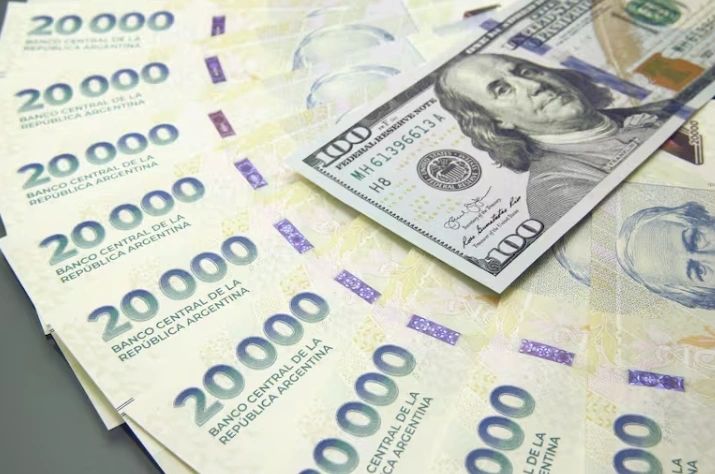BuySellBA
Administrator
Mortgage loans: the amount of the installments to be paid can vary up to 100% depending on the rate - La Nacion Propiedades

Source:

 www.lanacion.com.ar
www.lanacion.com.ar
October 14, 2025
Banco Nación maintains its 4.5% rate, but with a nearly impossible scoring, while in some private banks the rate has already climbed to 17%.
By Candela Contreras

Banks raised rates and tightened mortgage loan conditions. FreePik
Mortgage lending showed movement again in September : US$353 million in loans were disbursed, the best record since May 2018. However, behind this encouraging figure lies a reality that discourages any enthusiasm : the gap between the lowest and highest rates on the market today is so wide that, in practice, it defines who can access their own home and who is definitely left out .
While Banco Nación maintains its historic annual rate of 4.5% plus UVA , some banks are already climbing to 17% , especially for customers who don't deposit their paychecks with those institutions. The difference is significant: on a US$100,000 property loan , with a US$25,000 down payment and 75% financed over 30 years , the installments can vary dramatically.
At the Nación rate, the first installment would be around $704,220 , and the required family income would be $2,112,661 . But with the 15% rate—which Galicia, Santander, Macro, Supervielle, and BBVA have—the initial installment jumps to $1,454,739 , and the required income climbs to $4,364,318 , that is, 106% more . In other words: the same apartment with credit, but with two completely different realities.

There is a 183% difference between the lowest and highest rates. Getty Images
“Today, the Pope, Messi, and a few others qualify for a mortgage loan from Banco Nación,” quips Juan Manuel Tapiola, CEO of the developer Spazios. “We tested employees with impeccable credit scores, and they didn't make the cut: they stayed at 800 points. In practice, it's as if they were telling you there's no credit .”
The tightening is no coincidence. In a country where banks are unable to secure long-term funding, offering 20- or 30-year loans has become an impossible equation . Those banks that still do so compensate with higher rates or stricter filters.
Even with the encouraging September figures, analysts explain that these loans correspond to approvals prior to the dollar's rise and a more moderate interest rate scenario. "These are transactions that have been in the works for four months or more, amidst the pre-election stability," industry insiders agree.

The loans granted in September were mostly requested in July, with a lower dollar and more moderate rates.Kikinunchi - Shutterstock
According to Federico González Rouco, an economist specializing in housing, many of the current applications "correspond to applications initiated about three months ago, before the September elections in the province of Buenos Aires." He explains that at that time, rates "were already high, but a little lower than they are now." He also points out that the impact of the dollar remains significant: " The perception that this may be coming to an end is causing people to rush to secure credit and seek strategies to compensate for what the dollar takes away from their potential financing."
The economist adds that the point at which a devaluation completely cuts off credit has not yet been reached, but that " an acceleration effect prior to the national elections could be observed , driven by expectations of what might happen next."
Meanwhile, economist Andrés Salinas doesn't believe that "there will be an advance in operations due to fear of a post-election adjustment." According to him, and in agreement with González Rouco, the September disbursement figures correspond to loans that began their application process about two months earlier , that is, in July. "At that time, although rates were high, the electoral climate was different—the provincial elections hadn't yet taken place—and some bank requirements were still quite lax, for example, the scoring issue ," he explains.
Salinas adds that, although some applicants may have insisted on having their loans approved before the elections, the banks control the timing: "If there was someone waiting for the process to be finalized, they wanted it as soon as possible, but ultimately the banks determine the bulk of the timeframes."
At the same time, he warns that demand remains strong even with high rates , which he considers "extremely dangerous." "These two months, we've seen several rate hikes, and from high levels. This tells us that even at these real rates, people continue to demand credit," he points out.
Looking ahead to the remainder of the year, Salinas asserts that the future of mortgage lending will largely depend on the election results . "I know that several banks have slowed down their lending—and some have even stopped completely—while waiting to see what will happen in October," he explains. "The key will be whether there is a subsequent change in the monetary system that impacts the liquidity of the system, which is what ultimately determines the percentage that banks allocate to loans," he maintains.
The economist doesn't see a likely rate cut to the levels seen in the second half of 2024, although he does anticipate some flexibility if the election results are favorable: "There could be longer terms, higher amounts, or less stringent scoring requirements."
The gap highlights a structural issue: without long-term funding and with a high country risk, the Argentine financial system cannot sustain a solid mortgage market . The consequences are predictable: stalled transactions, families left in the lurch, and a real estate market that loses one of its main drivers of demand.
www.buysellba.com
Source:

Créditos hipotecarios: el monto de las cuotas a pagar puede variar hasta un 100% según la tasa
El Banco Nación mantiene su tasa del 4,5%, pero con un scoring casi imposible, mientras que en algunos bancos privados la tasa ya trepa al 17%
October 14, 2025
Banco Nación maintains its 4.5% rate, but with a nearly impossible scoring, while in some private banks the rate has already climbed to 17%.
By Candela Contreras

Banks raised rates and tightened mortgage loan conditions. FreePik
Mortgage lending showed movement again in September : US$353 million in loans were disbursed, the best record since May 2018. However, behind this encouraging figure lies a reality that discourages any enthusiasm : the gap between the lowest and highest rates on the market today is so wide that, in practice, it defines who can access their own home and who is definitely left out .
While Banco Nación maintains its historic annual rate of 4.5% plus UVA , some banks are already climbing to 17% , especially for customers who don't deposit their paychecks with those institutions. The difference is significant: on a US$100,000 property loan , with a US$25,000 down payment and 75% financed over 30 years , the installments can vary dramatically.
At the Nación rate, the first installment would be around $704,220 , and the required family income would be $2,112,661 . But with the 15% rate—which Galicia, Santander, Macro, Supervielle, and BBVA have—the initial installment jumps to $1,454,739 , and the required income climbs to $4,364,318 , that is, 106% more . In other words: the same apartment with credit, but with two completely different realities.

There is a 183% difference between the lowest and highest rates. Getty Images
The last bastion (increasingly inaccessible)
The case of Banco Nación became a separate phenomenon. For months, it was seen as "the last bastion" of reasonable rates . But instead of raising the rate, as happened with most banks, that advantage became almost illusory due to the scoring required to access its loans: it doubled , going from 450 to 909 points .“Today, the Pope, Messi, and a few others qualify for a mortgage loan from Banco Nación,” quips Juan Manuel Tapiola, CEO of the developer Spazios. “We tested employees with impeccable credit scores, and they didn't make the cut: they stayed at 800 points. In practice, it's as if they were telling you there's no credit .”
The tightening is no coincidence. In a country where banks are unable to secure long-term funding, offering 20- or 30-year loans has become an impossible equation . Those banks that still do so compensate with higher rates or stricter filters.
Even with the encouraging September figures, analysts explain that these loans correspond to approvals prior to the dollar's rise and a more moderate interest rate scenario. "These are transactions that have been in the works for four months or more, amidst the pre-election stability," industry insiders agree.

The loans granted in September were mostly requested in July, with a lower dollar and more moderate rates.Kikinunchi - Shutterstock
According to Federico González Rouco, an economist specializing in housing, many of the current applications "correspond to applications initiated about three months ago, before the September elections in the province of Buenos Aires." He explains that at that time, rates "were already high, but a little lower than they are now." He also points out that the impact of the dollar remains significant: " The perception that this may be coming to an end is causing people to rush to secure credit and seek strategies to compensate for what the dollar takes away from their potential financing."
The economist adds that the point at which a devaluation completely cuts off credit has not yet been reached, but that " an acceleration effect prior to the national elections could be observed , driven by expectations of what might happen next."
Meanwhile, economist Andrés Salinas doesn't believe that "there will be an advance in operations due to fear of a post-election adjustment." According to him, and in agreement with González Rouco, the September disbursement figures correspond to loans that began their application process about two months earlier , that is, in July. "At that time, although rates were high, the electoral climate was different—the provincial elections hadn't yet taken place—and some bank requirements were still quite lax, for example, the scoring issue ," he explains.
Salinas adds that, although some applicants may have insisted on having their loans approved before the elections, the banks control the timing: "If there was someone waiting for the process to be finalized, they wanted it as soon as possible, but ultimately the banks determine the bulk of the timeframes."
At the same time, he warns that demand remains strong even with high rates , which he considers "extremely dangerous." "These two months, we've seen several rate hikes, and from high levels. This tells us that even at these real rates, people continue to demand credit," he points out.
Looking ahead to the remainder of the year, Salinas asserts that the future of mortgage lending will largely depend on the election results . "I know that several banks have slowed down their lending—and some have even stopped completely—while waiting to see what will happen in October," he explains. "The key will be whether there is a subsequent change in the monetary system that impacts the liquidity of the system, which is what ultimately determines the percentage that banks allocate to loans," he maintains.
The economist doesn't see a likely rate cut to the levels seen in the second half of 2024, although he does anticipate some flexibility if the election results are favorable: "There could be longer terms, higher amounts, or less stringent scoring requirements."
Impossible rates, unattainable requirements
The trend is clear: private banks are tightening conditions while raising rates . Galicia and BBVA already have a ceiling of 17%, followed by Macro, Supervielle, and Santander (15%), ICBC, and Patagonia (14% for those who do not receive a salary from the bank). On average, the nominal annual rate on UVA loans in Argentina is around 10.6 % , almost double that of Chile , where a similar system (the UF) has a rate of 5.19% .The gap highlights a structural issue: without long-term funding and with a high country risk, the Argentine financial system cannot sustain a solid mortgage market . The consequences are predictable: stalled transactions, families left in the lurch, and a real estate market that loses one of its main drivers of demand.
www.buysellba.com

